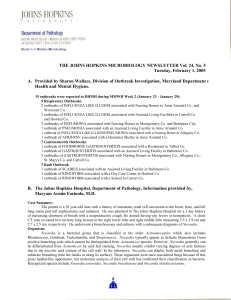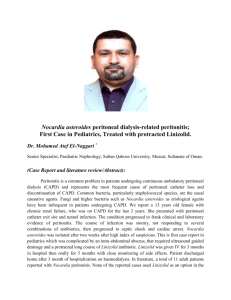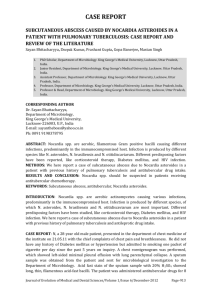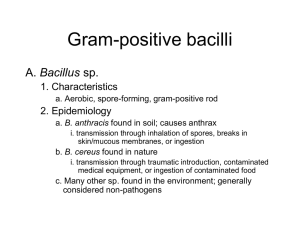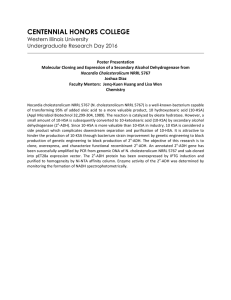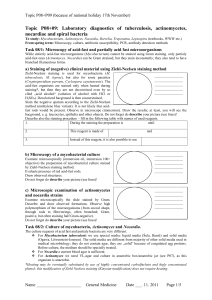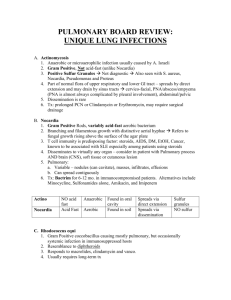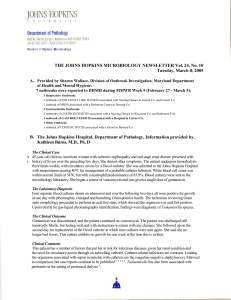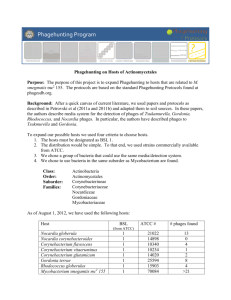Volume 24 - No 26: Nocardia
advertisement
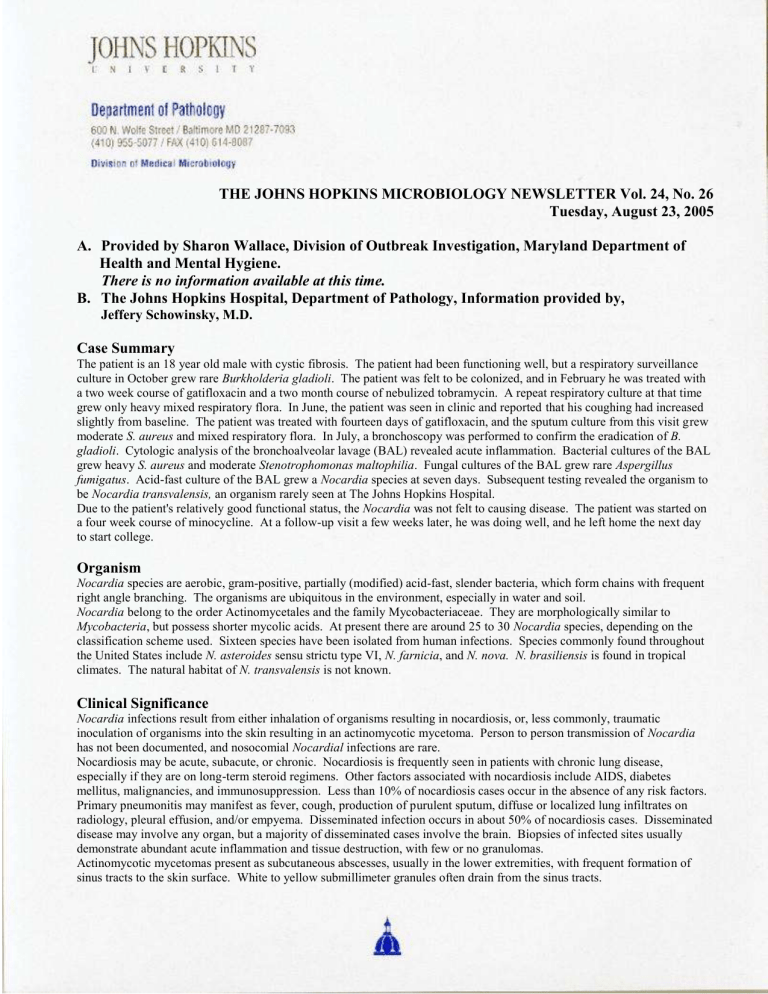
THE JOHNS HOPKINS MICROBIOLOGY NEWSLETTER Vol. 24, No. 26 Tuesday, August 23, 2005 A. Provided by Sharon Wallace, Division of Outbreak Investigation, Maryland Department of Health and Mental Hygiene. There is no information available at this time. B. The Johns Hopkins Hospital, Department of Pathology, Information provided by, Jeffery Schowinsky, M.D. Case Summary The patient is an 18 year old male with cystic fibrosis. The patient had been functioning well, but a respiratory surveillance culture in October grew rare Burkholderia gladioli. The patient was felt to be colonized, and in February he was treated with a two week course of gatifloxacin and a two month course of nebulized tobramycin. A repeat respiratory culture at that time grew only heavy mixed respiratory flora. In June, the patient was seen in clinic and reported that his coughing had increased slightly from baseline. The patient was treated with fourteen days of gatifloxacin, and the sputum culture from this visit grew moderate S. aureus and mixed respiratory flora. In July, a bronchoscopy was performed to confirm the eradication of B. gladioli. Cytologic analysis of the bronchoalveolar lavage (BAL) revealed acute inflammation. Bacterial cultures of the BAL grew heavy S. aureus and moderate Stenotrophomonas maltophilia. Fungal cultures of the BAL grew rare Aspergillus fumigatus. Acid-fast culture of the BAL grew a Nocardia species at seven days. Subsequent testing revealed the organism to be Nocardia transvalensis, an organism rarely seen at The Johns Hopkins Hospital. Due to the patient's relatively good functional status, the Nocardia was not felt to causing disease. The patient was started on a four week course of minocycline. At a follow-up visit a few weeks later, he was doing well, and he left home the next day to start college. Organism Nocardia species are aerobic, gram-positive, partially (modified) acid-fast, slender bacteria, which form chains with frequent right angle branching. The organisms are ubiquitous in the environment, especially in water and soil. Nocardia belong to the order Actinomycetales and the family Mycobacteriaceae. They are morphologically similar to Mycobacteria, but possess shorter mycolic acids. At present there are around 25 to 30 Nocardia species, depending on the classification scheme used. Sixteen species have been isolated from human infections. Species commonly found throughout the United States include N. asteroides sensu strictu type VI, N. farnicia, and N. nova. N. brasiliensis is found in tropical climates. The natural habitat of N. transvalensis is not known. Clinical Significance Nocardia infections result from either inhalation of organisms resulting in nocardiosis, or, less commonly, traumatic inoculation of organisms into the skin resulting in an actinomycotic mycetoma. Person to person transmission of Nocardia has not been documented, and nosocomial Nocardial infections are rare. Nocardiosis may be acute, subacute, or chronic. Nocardiosis is frequently seen in patients with chronic lung disease, especially if they are on long-term steroid regimens. Other factors associated with nocardiosis include AIDS, diabetes mellitus, malignancies, and immunosuppression. Less than 10% of nocardiosis cases occur in the absence of any risk factors. Primary pneumonitis may manifest as fever, cough, production of purulent sputum, diffuse or localized lung infiltrates on radiology, pleural effusion, and/or empyema. Disseminated infection occurs in about 50% of nocardiosis cases. Disseminated disease may involve any organ, but a majority of disseminated cases involve the brain. Biopsies of infected sites usually demonstrate abundant acute inflammation and tissue destruction, with few or no granulomas. Actinomycotic mycetomas present as subcutaneous abscesses, usually in the lower extremities, with frequent formation of sinus tracts to the skin surface. White to yellow submillimeter granules often drain from the sinus tracts. Epidemiology The vast majority of cases of nocardiosis are due to the N. asteroides complex, which includes N. asteroides sensu strictu type VI, N. farnicia, N. nova, N. brasiliensis, and N. otitisdiscaviarum (formerly N. caviae). The more recently identified species N.transvalensis, N. africana, N. brevicatena, and N. paucivorans are rarely isolated. N. farnicia is especially likely to be associated with disseminated disease. N. nova is rarely associated with extrapulmonary disease. N. brasiliens and N. transvalensis typically infect the patient through a skin abrasion, rather than the normal pulmonary route. N. brasiliensis and N. otitisdiscaviarum are responsible for the majority of Nocardial mycetomas. Laboratory Diagnosis Nocardia will grow in a wide variety of culture media, including sheep blood, Lowenstein-Jensen, and Sabourad dextrose agar, and at temperatures ranging from 25 to 45C. Nocardia cultures may take anywhere from four days to six weeks to turn positive. Cultures performed on mycobacterial media (e.g. Lowenstein-Jensen) usually grow in one to two weeks. Nocardia will survive the NaOH digestion procedure performed on acid-fast culture specimens. Growth may be enhanced by culturing in 10% CO2. Nocardia organisms will be identified via Gram staining of infected material in about 60-70% of cases. Of these, about half will also be positive on subsequent modified acid-fast staining, but this percentage varies from laboratory to laboratory. Nocardia may be separated from Mycobacteria in that Nocardia will be negative on true acid-fast stains (Kinyoun, Ziehl-Neelsen). Additionally, some Mycobacteria are positive in the arylsulfatase test, while Nocardia are negative. Observation of branching filaments also suggests Nocardia over Mycobacteria, although a few rapid-growing Mycobacteria may produce filamentous forms. Nocardia may be differentiated from Streptomyces by Nocardia's resistance to degradation by lysozyme. Panels of biochemical tests and growth patterns at different temperatures are no longer sufficient to routinely separate different species of Nocardia. Cell was fatty acid analysis via gas liquid chromatography is one possible method of speciation. Currently, The Johns Hopkins Hospital sends cultures to the Mycobacterial / Nocardia Research Laboratory of the University of Texas in Tyler, Texas, for speciation and sensitivity testing. Serologic tests are not currently available for the detection of Nocardia. Treatment Sulfa-containing drugs are the drugs of choice for Nocardial infections. Other effective primary drugs include minocycline, amikacin, imepenem, and linezolid. In serious infections, use of one of these four drugs in combination with a sulfa-containing drug is recommended, especially amikacin-imepenem. The duration of antibiotic therapy is not well defined, but a relatively long course is recommended. N. transvalensis is notable in that it is frequently resistant to aminoglycosides. REFERENCES: Koneman, E.W. Color Atlas and Textbook of Diagnostic Microbiology, 5th ed. Lippincott-Raven, 1997. Saubolle, M.A. and Sussland, D. Nocardiosis: Review of Clinical and Laboratory Experiences. Journal of Clinical Microbiology, 41(10): 4497-4501, Oct 2003. Yorke, F.Y. and Rouah, E. Nocardiosis with Brain Abscess due to an Unusual Species, Nocardia transvalensis. Archives of Path and Lab Med, 127: 224-226, Feb 2003.
